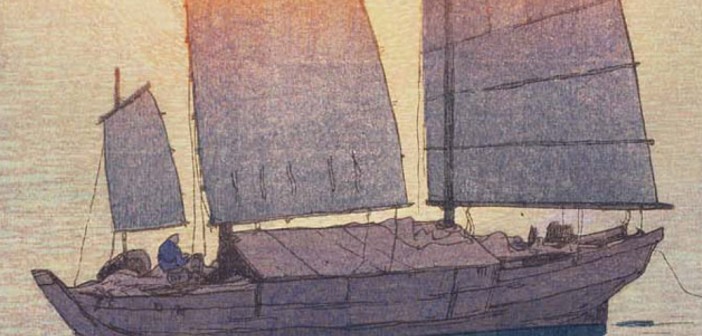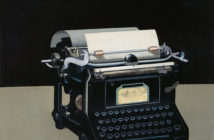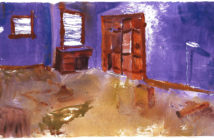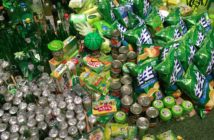"The Creative Process in Modern Japanese Printmaking" is an all-too tiny exhibit at the MFA--typical but unfortunate for a museum that houses the largest collection of Japanese prints in the United States. Nonetheless, the show is an oasis of quietude and sublime detail among the museum’s larger dark, imperious Asian galleries. Covering a defining moment in Japanese printmaking, the focus of the exhibit is the move from ukiyo-e ("The Floating World") prints of the 18th and 19th centuries, which most of us associate with Japanese prints, to a new breed of prints made for pleasure and non-commercial distribution.
Ukiyo-e is meant to define the ephemeral nature of life with a focus on the pleasures of those fleeting moments. While familiar names like Hokusai, Utamaro and Hiroshige have come to define this era, hundreds of artists working in Edo (now Tokyo) and dozens of publishers were producing imagery consisting of landscapes, actors, seductive beauties, flowers, animals, ghost stories, samurai, and heavily sexualized scenes. However, these prints were in no way looked upon as art, instead serving as mere reproductions of drawings destroyed in the carving process, of so little value that they eventually arrived in Europe in the form of wrapping for porcelain (and upon discovery, were embraced by the Post-Impressionists, creating the Japanism craze).
While the artists were renowned for their imagery, their prints were based on drawings that were pasted to a woodblock and sent through an assembly line wherein the drawing was cut through by master carvers, moved to teams of printers, and published in enormous quantities. The meticulous, time-consuming process of this kind of printing begins with the creation of a keyblock that defines the image through outline, akin to a coloring book illustration, before being filled in. Subsequent blocks are then created for colors. A liquid ink of pigment and rice starch paste is rubbed over the block with a flat brush and dampened Japanese paper is rubbed with a disc, or baren, to pick up the ink. The process is repeated with each block.
In the years following the country's reopening to the West in 1853, Japanese artists were gradually introduced to other means of reproduction (i.e. lithography and photography) to supplant this 200 year-old process (the MFA exhibition dates this sea change to 1905). Still, numerous artists clung to it for its inimitable qualities (e.g. the vibrant colors and wood grain), and the current exhibition covers the two broad categories into which this new breed of prints fell: shin hanga (made in the traditional collaborative method); and sōsaku hanga (wherein a single artist working alone produced prints in their entirety).
Prints made in the collaborative shin hanga school were no different in their production from the ukiyo-e prints that preceded them: they were still made on assembly lines in editions of varying sizes and color. The show’s touted centerpiece is six versions of Doshida Hiroshi’s Sailboats of 1926. As in Monet’s Haystacks or Rouen Cathedral, we see the same boats at different times of day, and the wide variation of mood, color and definition printed from the same (to my counting) four blocks. At times the imagery is crisp, with a clearly delineated horizon and contrasting colors comprising the choppy waters (as inAfternoon). At others the image becomes lost in haze, such as Morning, which boasts an astounding feat of bokashi (the fading of one color into another), where blended colors radiate out in hazy rings around a rising sun. In Fog, the landscape is lost and a now ghostly boat is obfuscated by gradations of grays. One can walk along this wall for hours and become ever more baffled by changes in background alone, ranging from a crisp afternoon to the winking lights of the city at night. The span of this series stands as a definitive testament to the myriad of moods created by changes in color and variations in inking.
The other standout among the shin hanga prints is Girl in a Summer Costume by Hashuguchi Goyō. Printed posthumously in 1920 (Goyō died at age 40), it shows an almost standard image of a standing Japanese beauty in a long kimono. Here we can see the clearly delineated black lines of the keyblock that make the image, right down to the microscopic lines of the hairline and the squares comprising the framework of a lantern. Having created additional color blocks, the printers chose instead to include a minimum of background detail, leaving wide areas of gray, shimmering mica and a shade of white only slightly different from the warmer white of the paper. Aside from this strikingly modern use of flat space and minimal color, the only other feature distinguishing this work from the Ukiyo-e era period is the size: measuring roughly 18 x 14", it is much larger than the (roughly) 12 x 9" cherry blocks used in the previous centuries (hence their employment of triptychs for larger prints). Hanging beside it is a color version, as dull as the other is sublime: flat in its bland, busy colors as the other is striking in its simplicity, and a sad attempt at the recreation of ukiyo-e style on the part of the printers.
Three crowd-pleasing prints by Inagaki Tando (two from the same block) are impressive in their clever carving, though a bit dated in their mod, beatnik, lounge-style cool (granted, they were done in 1960). They are the embodiment of the sōsaku hanga: printed in the Japanese manner, they are closest to Western woodcuts in their contemporary style. Out of stylized, geometric lines emerges Tando’s penchant for cats: in one instance, the subjects are seated and peering out at us, in another, they are slinking along the docks trolling for fish. Tando’s brilliance is in his re-inking the blocks of the latter print in shades of blues that contrast much less than the defined blacks and greens of the first impression, somehow making what we know to be cats into a striking, large fish. His work speaks loudest to the growing stylistic synergy between the East and West during the jet setting, inter-continental mid-century.
The quiet standout among the sōsaku hanga is a trio of virtually identical prints entitled Mother and Child by Onchi Kōshirō, long considered the seminal founding father of sōsaku hanga. Kōshirō, known as much for his intricate, Western-leaning prints using the Japanese printing method as for his deceptively simple imagery, printed Mother and Child at various times between 1915 and 1955. Western influences abound: the undulating waves enveloping the pair evoke the embryonic cocoons that often encircle a central image in Munch’s lithographs; the sorrow imbued into the subject recalls the heartbreaking maternal tenderness and impending doom of Kollwitz; the downturn of the mother’s head is borrowed directly from Picasso’s The Old Guitarist of 1904. There is little variation among each print, all employing the same gray and black. While the wall didactics state that each was the product of one block, the use of two colors (black and gray) leaves no doubt that there were two. Had the three prints been completed at the same time they could have been printed using a reductive technique (that is, one block that had been only partially carved and printed in the gray, then carved away further and over-printed with the black). However, the fact that the prints were completed and distributed over a forty year period while still retaining the grays highlighting the mother’s cheek and running through the blacks within the enveloping swirls leaves no room for the possibility that one block was used.
An added trove within the show is a display case containing mid to late 20th century miniature books (kapon) by Takei Takeo, a popular children’s writer and illustrator. Here we see a range of technique and media ranging from white-line woodcut reminiscent of early Kandinsky or Blanch Lazelle; selectively inked woodcuts in the manner of Cassatt’s aquatints; florid lithography evoking the Arts and Crafts movement; and geometric letterpress with separately printed, overlaying plastic reminiscent of a National Geographic book wherein a plastic page is overlaid on a blank map to reveal state delineations, mountains or erosion. However, in this instance they resemble the simple, straight lines of some Max Ernst drawings or Italian Futurists. Strikingly contemporary (Takeo died in 1980), they are a thoughtful juxtaposition of text and imagery.
The argument could be made that the exhibit is even more powerful for its ability to dazzle the viewer with technique, detail and a range of style while at the same time displaying so few pieces. Still, one hopes that we won’t have to wait too long for a much larger exhibition to reveal the full range of the hidden trove tucked away somewhere in the museum’s basement.
"The Creative Process in Modern Japanese Printmaking at the Museum of Fine Arts" is on view at the Museum of Fine Arts Boston until August 17, 2014.
Further information here.





